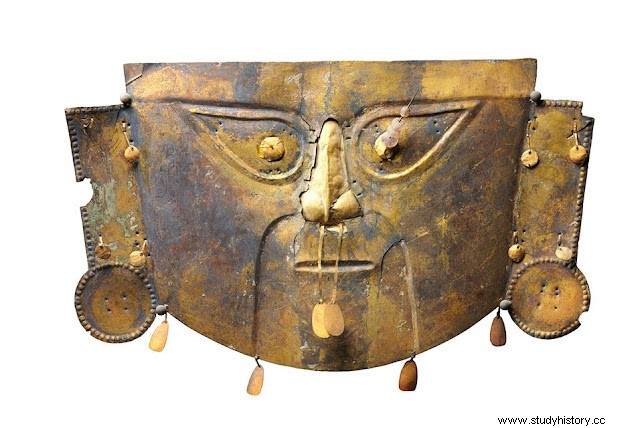In recent decades, the history of Peru has been enriched by the results of the efficient work of archaeological projects that constantly surprise us with their discoveries. Archaeologists interpret cultural material in order to explain the use and function of objects, enclosures or temples, these interpretations being the ones that provide a better understanding of the historical legacy of the ancestors.
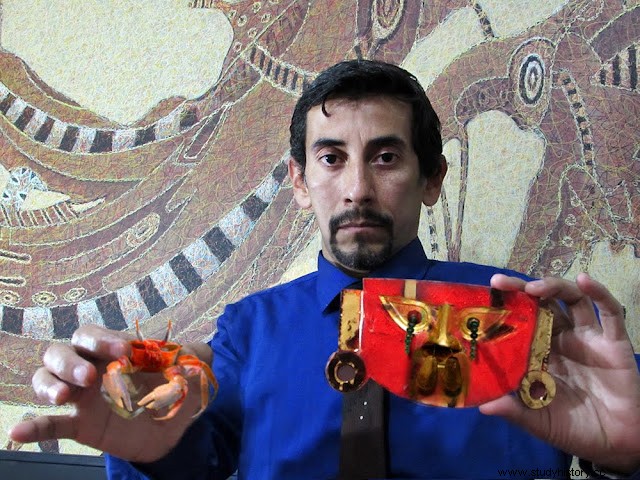
Andean man was always linked to the observation of natural phenomena, and to through it he could recognize his surroundings, and by recognizing them, understand them and then search them for their inherent attributes or powers. The wise men or leaders developed a social structure that became complex when collective thought transformed them into gods or deities, and they discovered tools to be able to interact with these forces. Thus, magic appears with the rite and societies were growing and interacting with each other:they exchanged food, objects and also ideologies; which were expressed in conventional images or symbols embodied in objects of various materials, thus allowing their ideas to be perpetuated in the group. The Lambayeque or Sicán culture developed in the middle valley of the La Leche River - Province of Ferreñafe, highlighted in architecture and dominated goldsmithing. It is in this activity that a very particular representation stands out, we refer to the well-known "Funeral Masks with Almond Eyes" which always accompany the deceased of high rank or importance. These masks are made of gold sheets painted red, with large almond-shaped eyes and some pieces have extensions in the form of eye stalks made of quartz or emerald beads, strung on thin tubes or wires. It has a small nose and mouth, it wears nose rings and nasal fringes, it also has circular earmuffs.
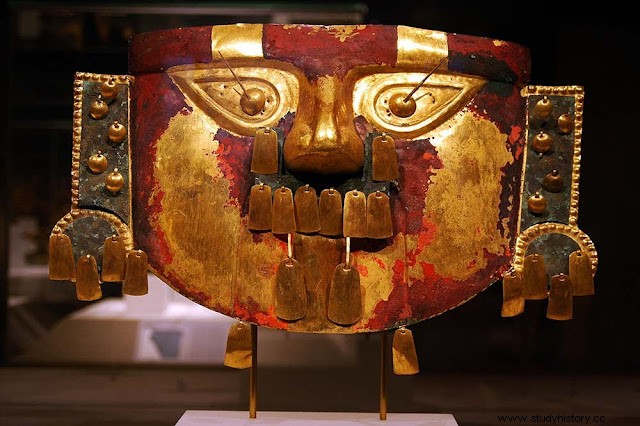 (Sicán mask photo, Sicán museum – Lambayeque) To explain the possible functionality of this mask, a hypothesis is proposed whose main evidence is the analogical comparisons between the stylization of the mask and the natural designs of a crustacean, called the "ghost crab" (Ocypode gaudichaudii) known by that name from its ability to appear and disappear inside its holes that dig deep in the dry areas of the beach, being able to move in the dark without any problem. They are also known as “carriers” or “runner crabs”, they feed on the waste thrown by the sea, including corpses, where they concentrate massively to feed, especially at night since they are more active.
(Sicán mask photo, Sicán museum – Lambayeque) To explain the possible functionality of this mask, a hypothesis is proposed whose main evidence is the analogical comparisons between the stylization of the mask and the natural designs of a crustacean, called the "ghost crab" (Ocypode gaudichaudii) known by that name from its ability to appear and disappear inside its holes that dig deep in the dry areas of the beach, being able to move in the dark without any problem. They are also known as “carriers” or “runner crabs”, they feed on the waste thrown by the sea, including corpses, where they concentrate massively to feed, especially at night since they are more active.Its most outstanding features are: a smooth flattened carapace of red or orange color with white spots, face separated from the cap and slightly tilted forward, they have two pincers and eight ambulatory legs, their almond-shaped concavities stand out where their eye sockets are semi-transparent and exposed, which gives them an excellent 360° vision. If we make a physical comparison between the Lambayeque mask and the ghost crab, we observe that:both have transparent eye stalks that come out of almond-shaped cavities, they have a reddish coloration with two upper vertical lines, they have curved vertical grooves such as nasolabial furrows and hanging fringes on the below what could correspond to a nasal shape.
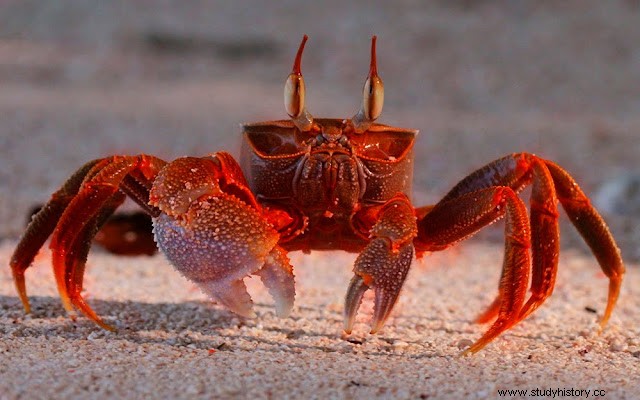 Ocypode gaudichaudii, known as carter or ghost crab The physical comparisons with the mask could well be just a curious coincidence, however, we find other elements of judgment to be taken into consideration and that are related to the magical and functional part of what would be the funerary rituals associated with the Lambayeque mask. To analyze these funerary practices, it is necessary to consider the perception of death from the perspective of the Andean worldview. According to the Spanish chroniclers (16th century) and ethnological research, death was conceived as a journey to another dimension of life, it was to descend to the underworld and was understood as a mysterious, dangerous and eternally dark place, made up of a multitude of paths where the deceased wandered and could easily get lost, for which it was necessary to provide him with everything a human being would need for a long journey. It was therefore important that he carry enough food, drinks, clothing, companions, animals and other useful objects, all according to the investiture and importance of the deceased. It should also be noted that many times symbolic elements were incorporated into funerary paraphernalia that could protect or help the individual, as could be the case with funerary masks.
Ocypode gaudichaudii, known as carter or ghost crab The physical comparisons with the mask could well be just a curious coincidence, however, we find other elements of judgment to be taken into consideration and that are related to the magical and functional part of what would be the funerary rituals associated with the Lambayeque mask. To analyze these funerary practices, it is necessary to consider the perception of death from the perspective of the Andean worldview. According to the Spanish chroniclers (16th century) and ethnological research, death was conceived as a journey to another dimension of life, it was to descend to the underworld and was understood as a mysterious, dangerous and eternally dark place, made up of a multitude of paths where the deceased wandered and could easily get lost, for which it was necessary to provide him with everything a human being would need for a long journey. It was therefore important that he carry enough food, drinks, clothing, companions, animals and other useful objects, all according to the investiture and importance of the deceased. It should also be noted that many times symbolic elements were incorporated into funerary paraphernalia that could protect or help the individual, as could be the case with funerary masks.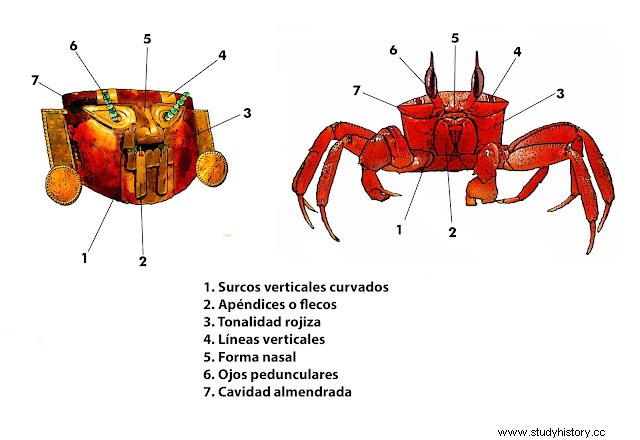
The mask in a ritual context has the capacity for communication and transformation of the individual who uses it, and unlike the theater, it is conceived as real. Therefore, if a character wears a condor mask, he will be the same incarnated condor and not just his representation, it is a mimetic transformation where the identity of the character is assumed and therefore the qualities and faculties are incorporated into the individual. of the being represented, in addition to protecting and hiding it. Considering this analysis, we could have a greater approximation and justification for the use of the "ghost crab" mask in Lambayeque rituals, since the crustacean is associated with death and it is very possible that when this mask was placed on the deceased, he acquired the faculties of the crustacean which allows it to move in the dark without problem, being the most outstanding being able to enter the underworld protected where apparently it would also be its natural environment. This crustacean was seen by the ancients as a being associated with death due to its scavenging and nocturnal activity, plus it naturally had the symbolic red color to be able to travel through the underworld, a color that coincidentally could also be associated with the moment the sun in the sunset (death of the sun) is appreciated reddish disappearing and that in an apparent perspective of his time, he would be starting his journey through the underworld to be reborn the next day in a new life.
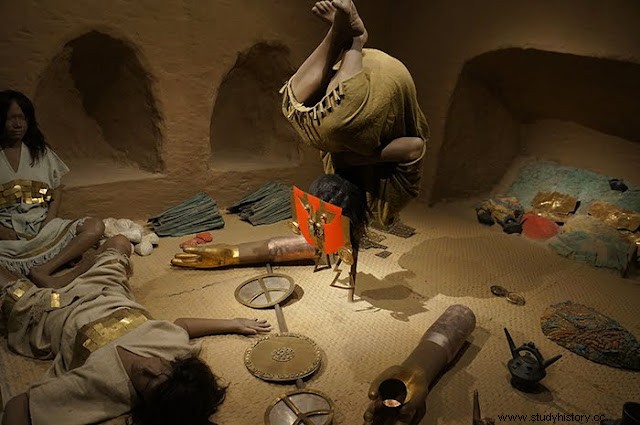 (Sicán burial representation - Sicán Museum) Finally, it is necessary to mention an archaeological evidence recorded in a Sicán tomb (Shimada 1978), where a character can be seen wearing the mask of the ghost crab and whose body position is unconventional, since he is upside down as if entering the tomb and a few centimeters in the lower part were placed two hands with forearms made of gold sheets but its scale is larger and disproportionate to be used as an accessory, and its apparent function was clearly symbolic. Would the claws of the ghost crab be represented?
(Sicán burial representation - Sicán Museum) Finally, it is necessary to mention an archaeological evidence recorded in a Sicán tomb (Shimada 1978), where a character can be seen wearing the mask of the ghost crab and whose body position is unconventional, since he is upside down as if entering the tomb and a few centimeters in the lower part were placed two hands with forearms made of gold sheets but its scale is larger and disproportionate to be used as an accessory, and its apparent function was clearly symbolic. Would the claws of the ghost crab be represented?